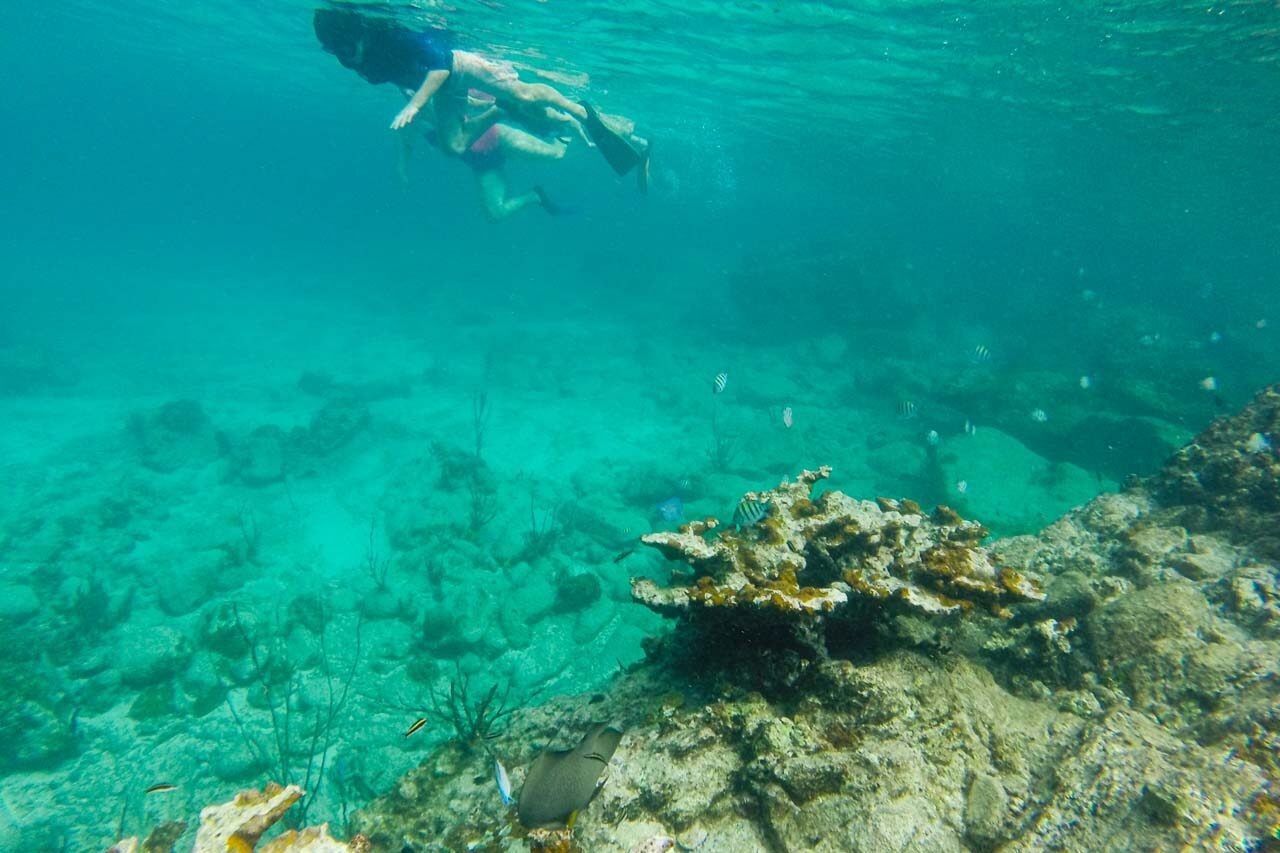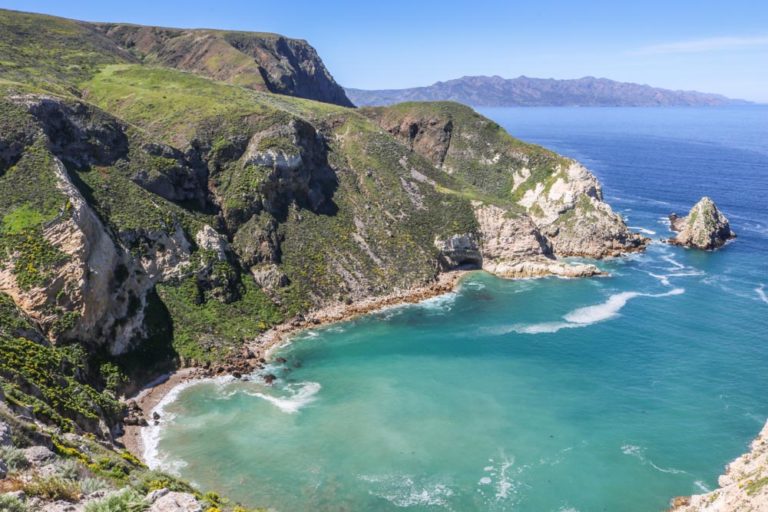Virgin Islands National Park Snorkeling Guide: Best Snorkeling Spots For Corals & Marine Life
One of America’s most tropical national parks, Virgin Islands National Park is as close to an island paradise as you can find without leaving the country. Encompassing a large part of the island of St. John, the park is also more than 40% water.
In fact, one of the main reasons Virgin Islands National Park was established in 1956 was the protection of its extraordinary Caribbean marine ecosystems. It comprises not only tropical forests, historic sugar plantations, and breathtaking beaches, but also some of the world’s greatest coral reefs.
This is all to say that Virgin Islands National Park is a dream destination for anyone who enjoys sunbathing, swimming in turquoise waters, sipping cocktails on a tropical beach, and snorkeling in vibrant reefs.
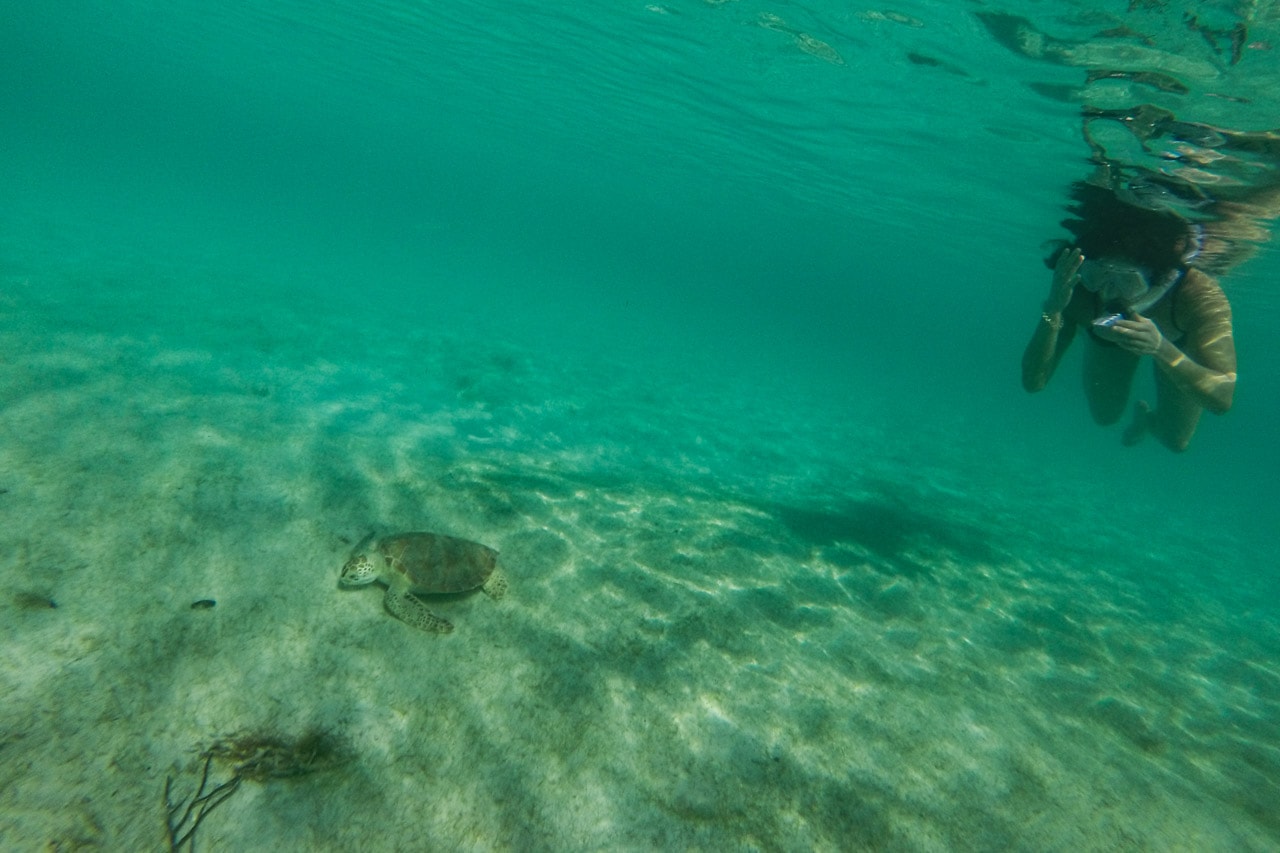
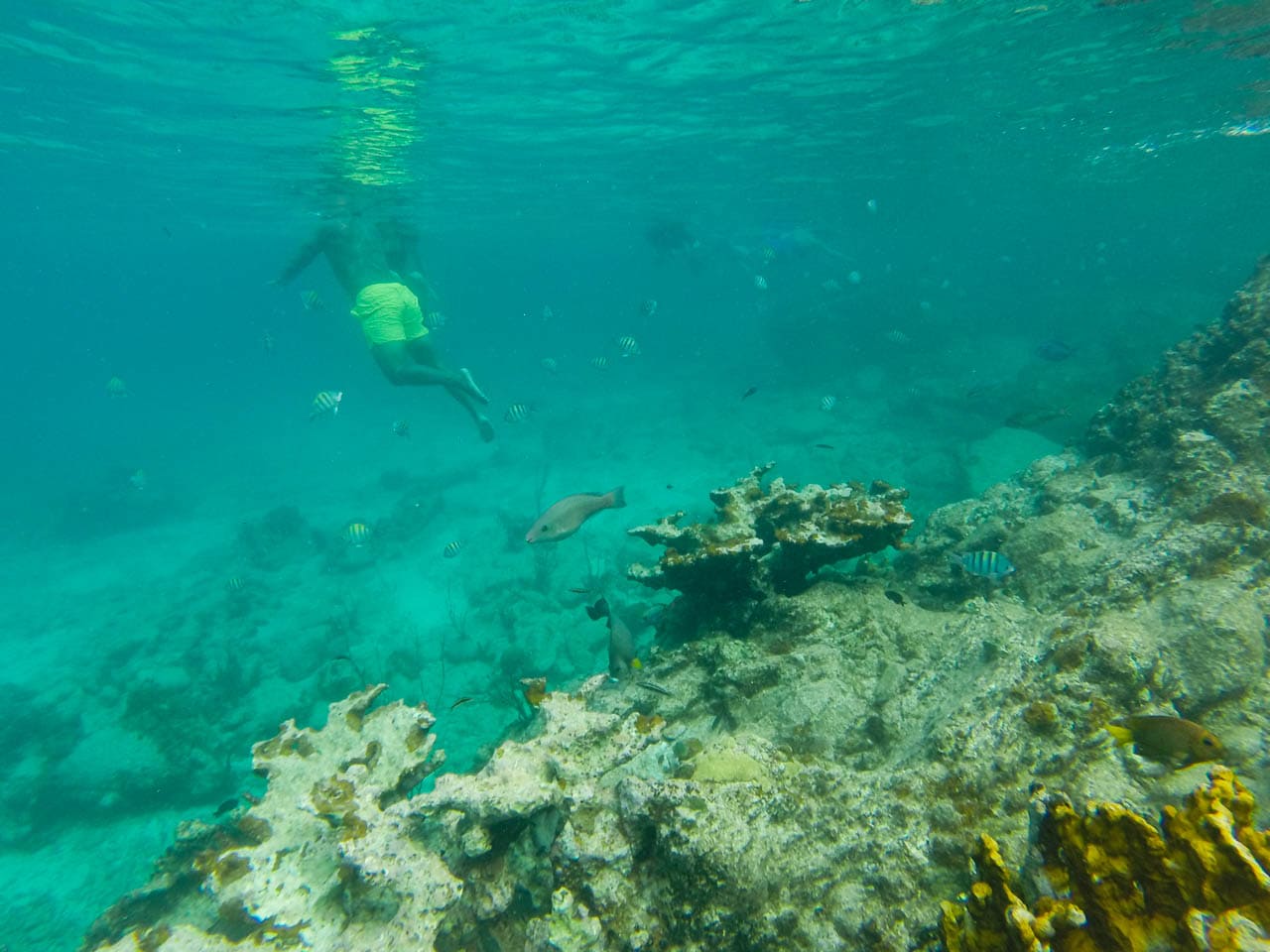
This guide to snorkeling in Virgin Islands National Park contains affiliate links. If you click on one of those links and make a purchase from one of our partners, we may earn a commission, without any extra cost to you. This helps support this website and ensures fair compensation for our team.
Snorkeling in Virgin Islands National Park, St. John
I can tell you from personal experience that spending a few days on the beaches of Virgin Islands National Park is something you will not regret—even if it’s rather expensive to get there and stay there.
I spent four days exploring the park’s greatest beaches, hiking trails, and snorkeling locations, and had an absolute blast!
In this Virgin Islands National Park snorkeling guide, which I created based on my own visit to the park, you’ll find all you need to know about exploring the park’s magnificent underwater world.
It includes everything from what equipment you need to animals you might see and, arguably most importantly, the best places to go snorkeling in St. John’s Virgin Islands National Park.
What Do I Need For a Snorkeling Holiday in the Virgin Islands?
For a getaway to the stunning Caribbean beaches of the U.S. Virgin Islands, you need your typical beach gear, plus some additional snorkeling equipment. I recommend bringing all of the following items:
- Beach towels
- Swimwear
- Beach blanket
- Beach tote bag
- Sunglasses
- Reef-safe sunscreen (it’s best to buy this when you get to St. John—more on this below)
- Snorkeling set (although you can rent snorkeling gear on the island, I decided to buy my own set beforehand—this is the one I got—and I did not regret it for one second!)
- Underwater camera (while not absolutely essential, trust me that you’re going to want to take some underwater photos when snorkeling in Virgin Islands National Park)
Can You Rent Snorkeling Gear on St. John?
You can rent beach equipment, including snorkeling sets, from various providers in Cruz Bay.
Additionally, you can also rent a variety of beach gear at a select number of beaches in Virgin Islands National Park, such as Trunk, Cinnamon, and Maho. This includes beach chairs, snorkeling gear, kayaks, and/or stand-up paddleboards (SUP).
As I said above, while you can rent snorkeling gear on the island, I’d recommend investing on your own set. It’s a one-time purchase, which you’ll be able to use for many years, that costs as much as a one-time rental on the island. I highly recommend this particular snorkeling set!
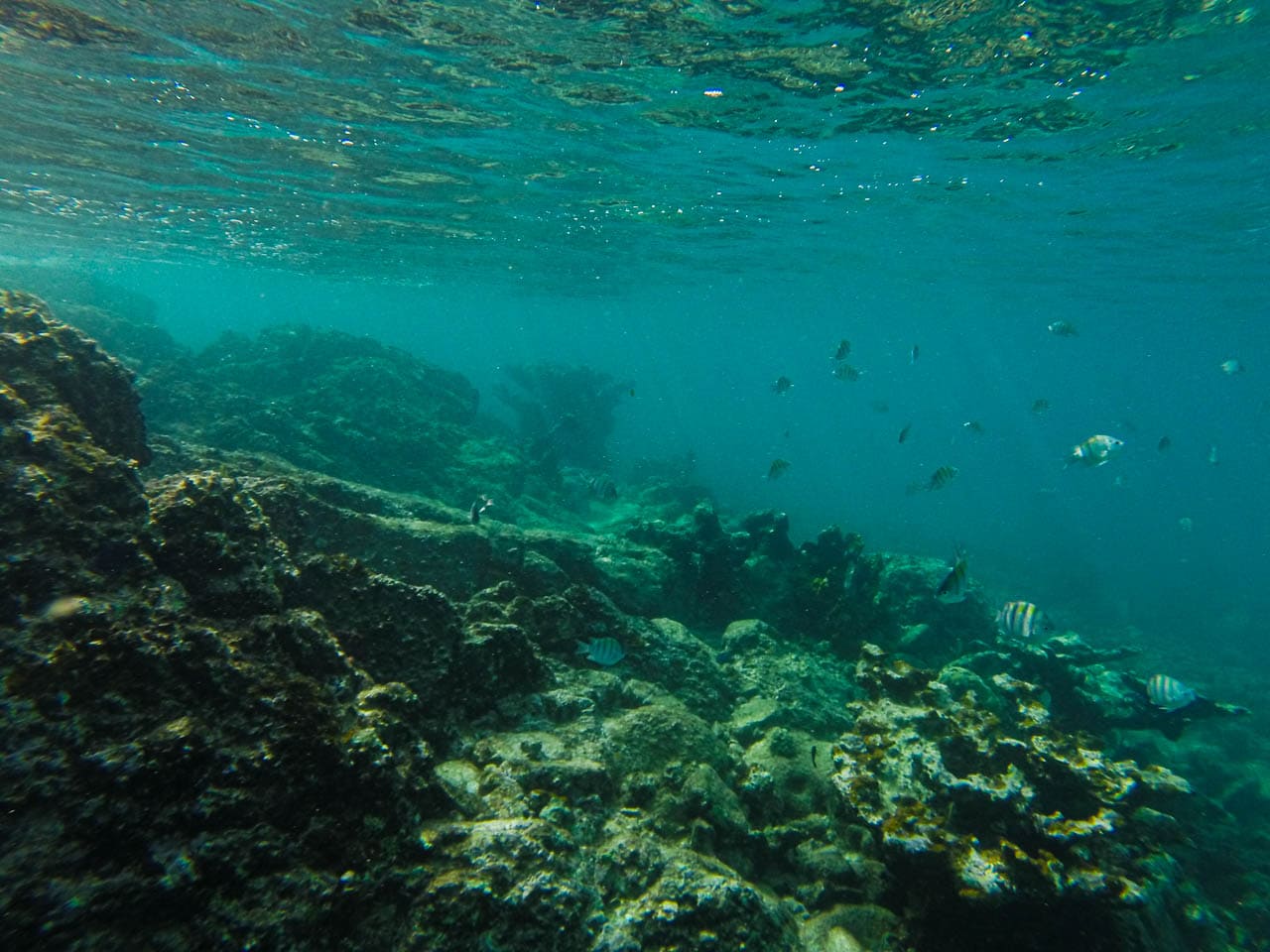
Are the Beaches in Virgin Islands National Park Free to Visit?
Generally speaking, yes, you can visit almost all of the beaches in Virgin Islands National Park free of charge. The only exception is Trunk Bay, which charges a day-use fee of $5 per person.
What Is the Best Time of Year to Go Snorkeling in the Virgin Islands?
Virgin Islands National Park is easily one of the best national parks to visit in winter. Its gloriously sunny weather, constantly high temperatures, and brilliant beaches make it arguably the best park to escape winter on the U.S. mainland.
Winter also happens to be the dry season in Virgin Islands National Park. Specifically, December through April is typically regarded as the best time to visit the Virgin Islands.
August through October, on the other hand, a hurricane season in the Caribbean. While you can still enjoy excellent weather and plenty of outdoor activities this time of year, it’s strongly advised to keep an eye on the weather forecast.
Is It Safe to Go Snorkeling in St. John, U.S. Virgin Islands?
Yes, if you use common sense and don’t go snorkeling during storms, it’s generally considered quite safe to explore the underwater world in Virgin Islands National Park.
The National Park Service does post some warnings on its website, though, which you should always take into consideration:
- Look, but don’t touch! If you need to rest while snorkeling, make sure to stand only on sandy surfaces. Don’t stand on corals or rocks, which can be very sharp and/or harbor marine life that can sting or bite, such as lionfish, scorpionfish, eels, or long-spined sea urchins.
- Watch our for stinging jellyfish in the summer months.
- Keep an eye on possible Yellow or Red Flag conditions. The park will alert visitors of potentially dangerous conditions through either Yellow Flag or Red Flag warnings. A Yellow Flag means there are “moderate ocean hazards with frequent large waves and possible rip currents.” A Red Flag indicates there are “extremely hazardous ocean conditions with large powerful waves and strong rip currents.”
- Take off any jewelry. Shiny objects like necklaces, rings, or bracelets may sparkle underwater and attract potentially dangerous fish like barracudas and sharks. Although the Park Service says that “shark attacks are extremely rare in the Virgin Islands,” it is advisable to take off all jewelry, avoid swimming at dawn or dusk, and stay on the beach if you have a wound or are bleeding.
- Don’t swim alone. Make sure to always swim with a partner!
You can find more information about what to avoid when snorkeling in Virgin Islands National Park here on the park’s website.
Where Should I Stay If I Want to Go Snorkeling in Virgin Islands National Park?
Although there are numerous private accommodation options all over the island of St. John, many of which are just outside the park’s boundaries, there is only one place to stay within the park itself.
The Cinnamon Bay Beach & Campground is located at popular Cinnamon Bay, the longest beach in the park, in between Trunk Bay and Maho Bay.
I strongly recommend trying to book a stay there first. It’s arguably the most strategic place to stay and offers a unique glamping experience in eco-tents near the beach. Besides eco-tents, there are bare tent platforms for rent as well. If you’d like a bit more luxury, you can also book a cottage a short walk from the beach.
Click here for other accommodation choices near Virgin Islands National Park, including vacation homes, villas, resorts, and hotels.
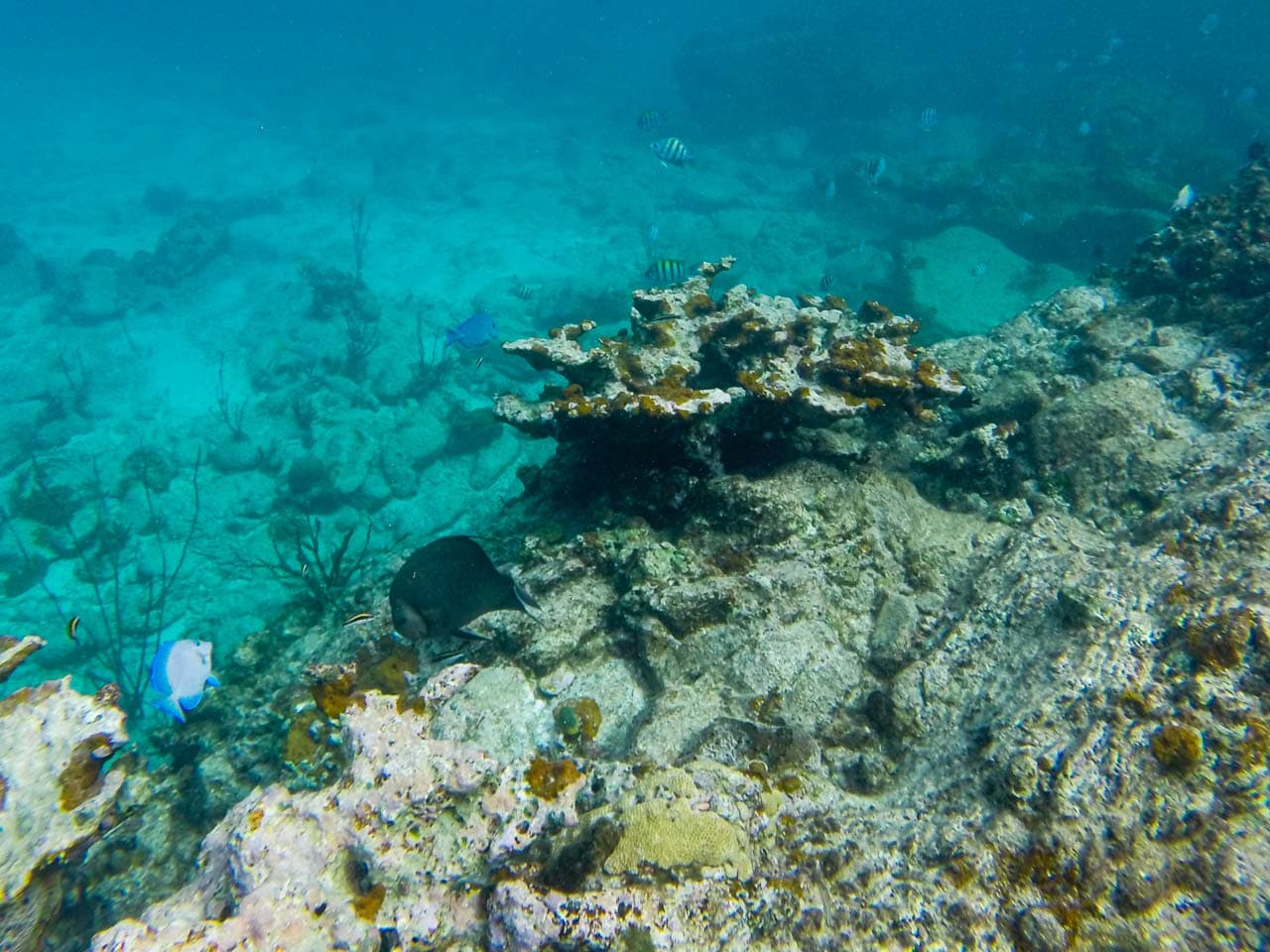
Where Is the Best Snorkeling in Virgin Islands National Park?
First of all, what constitutes “best” is different for everyone. Are you a complete beginner or an experienced snorkeler? Which marine animals would you like to see? Are you willing to hike a bit to get to a snorkeling location?
The answers to those questions will determine what are the “best” snorkeling spots in Virgin Islands National Park for you.
Generally speaking, however, there are several popular areas for snorkeling in St. John that are widely regarded as the top spots. Most of them are beginner-friendly, have shallow water, and are relatively easy to access—some do require a short hike, though.
After visiting a bunch of different snorkeling locations in the park, it’s my conclusion that the following are the top spots for snorkeling in Virgin Islands National Park:
- Honeymoon Bay
- Trunk Bay
- Maho Bay
- Francis Bay
- Leinster Bay and Waterlemon Cay
- Salt Pond Bay
You can find more details about each individual snorkeling area below, including its general location, which marine life you might see, amenities, and—of course—some (hopefully) enticing photos.
IMPORTANT!
It’s of critical importance to use reef-safe sunscreen when enjoying the stunning waters of Virgin Islands National Park.
Many common sunscreens have ingredients that kill corals and are extremely damaging to reefs. Avoid sunscreens that have substances like oxybenzone, octocrylene, octinoxate, butylparaben, and 4-methylbenzylidine camphor, all of which have been shown to cause coral bleaching even at low levels.
Additionally, there are no regulations for what sunscreen manufacturers are allowed to put on their bottles. Therefore, even if the label says “reef-safe,” the product may still contain those reef-damaging substances. Check the ingredients list before purchasing!
I recommend purchasing reef-safe sunscreen once you get to St. John. They’re widely available in local shops.
Best Snorkeling Spots in Virgin Islands National Park
1. Honeymoon Bay
Location: To the west of Caneel Bay, accessible via the Lind Point Trail from the Virgin Islands National Park Visitor Center.
Getting there: Easy 2.3-mile roundtrip hike (or by boat or island taxi)
Amenities: Restrooms, picnic tables, beach chair rentals, souvenir shop, snack bar, beach bars
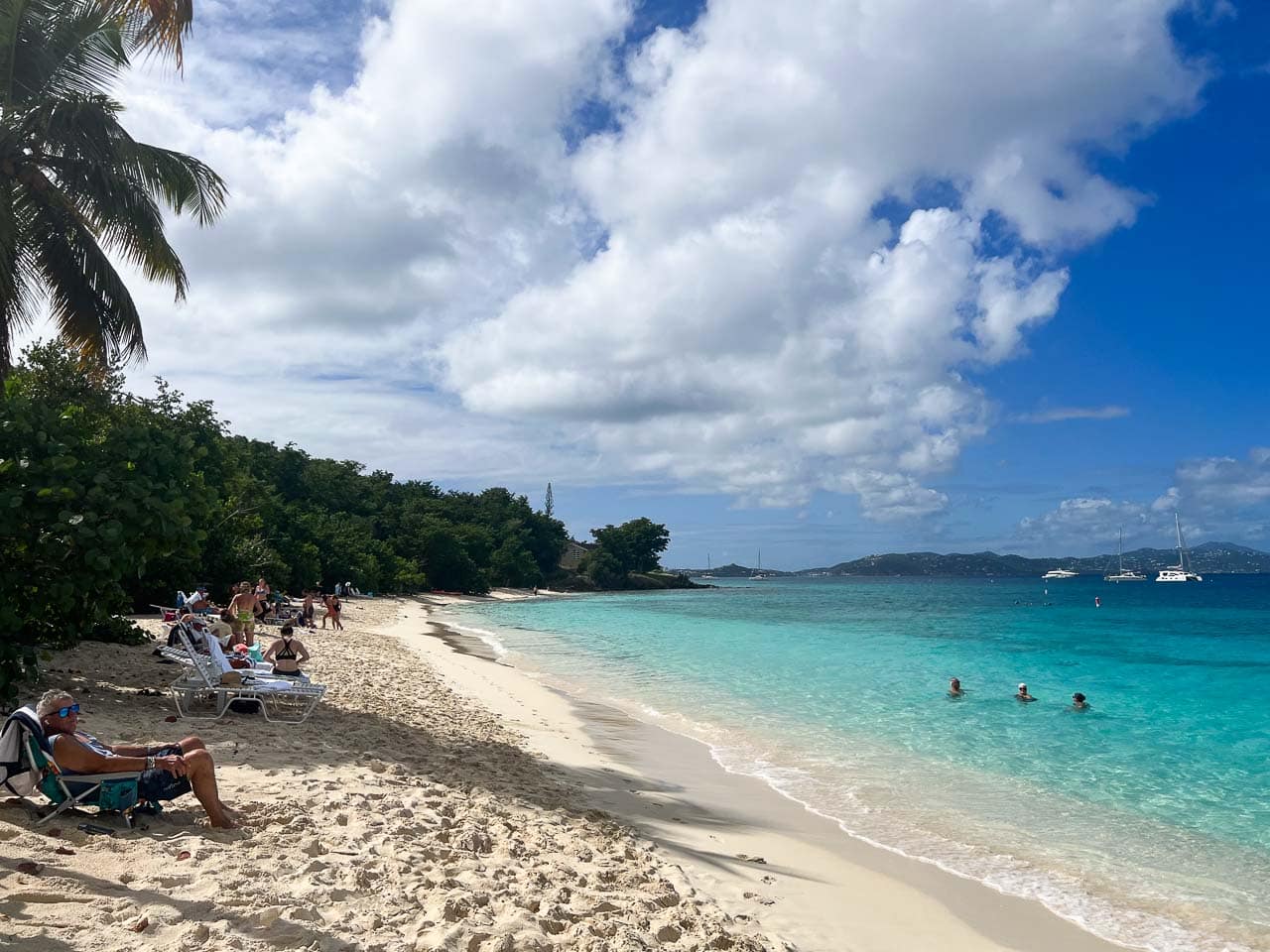
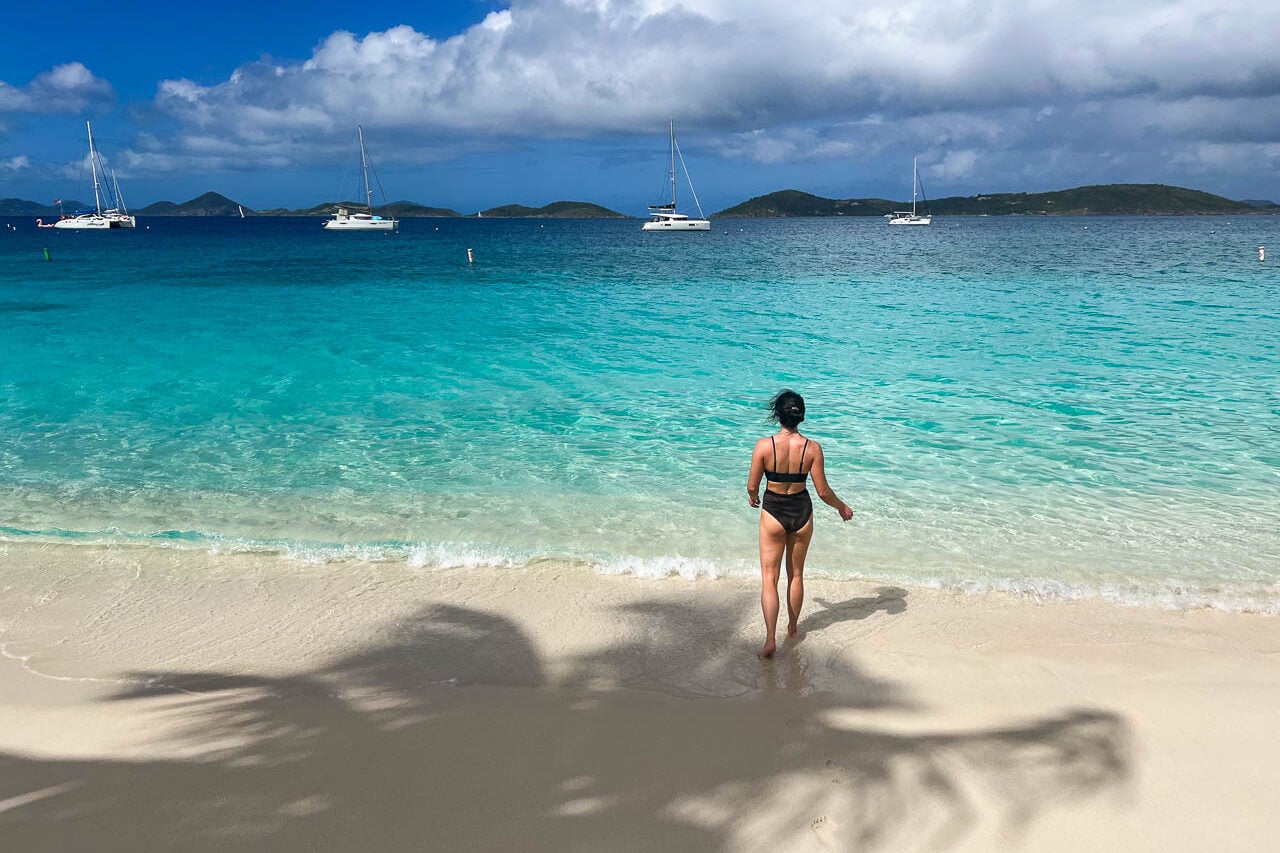
As its name suggests, Honeymoon Beach is absolutely beautiful—a white-sand beach fringed by palm trees and sea grapes, where waves gently lap against the shoreline.
It’s certainly one of the prettiest beaches in Virgin Islands National Park. You can get there either by boat, island taxi, or via the scenic Lind Point Trail, which starts at the Visitor Center in Cruz Bay. (When parking at the Visitor Center, make sure to get a NPS Parking Permit!)
The Lind Point Trail is made up of two sections: the Upper Lind Point and Lower Lind Point Trails.
I recommend hiking the upper trail to Honeymoon Beach, passing by the wonderful Lind Point Overlook on the way, and taking the lower trail back. It’s about 2.3 miles for the whole roundtrip hike.
At Honeymoon Beach, you can rent beach chairs, soak up some of that delightful Caribbean sunshine, and go snorkeling. The best snorkeling at Honeymoon Beach is along its eastern end, where a coral reef extends to Caneel Bay.
The reef consists of a variety of corals, including brain, elkhorn, lettuce leaf, pillar, and mustard hill corals. Numerous species of fish and other sea creatures find refuge among these corals.
2. Trunk Bay
Location: About 10 minutes east of Cruz Bay on North Shore Road, between Hawksnest and Cinnamon Bay.
Getting there: Roadside parking lot
Amenities: Restrooms, showers, changing rooms, exhibits and interpretive information, picnic tables, benches and pavilions, snack bar, beach bar, accessible paths, watersports rentals, underwater snorkeling trail
FEE: There is a day-use fee of $5 per person at Trunk Bay
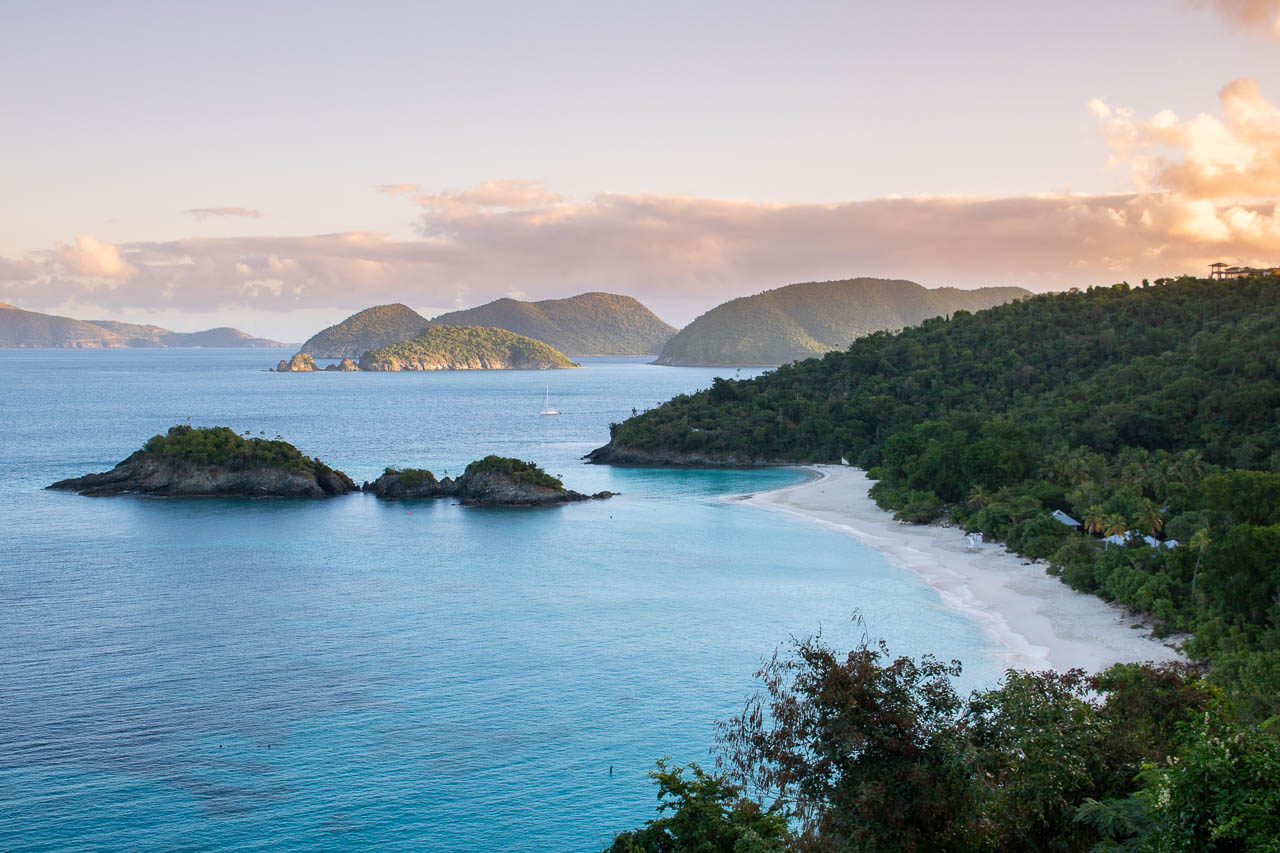
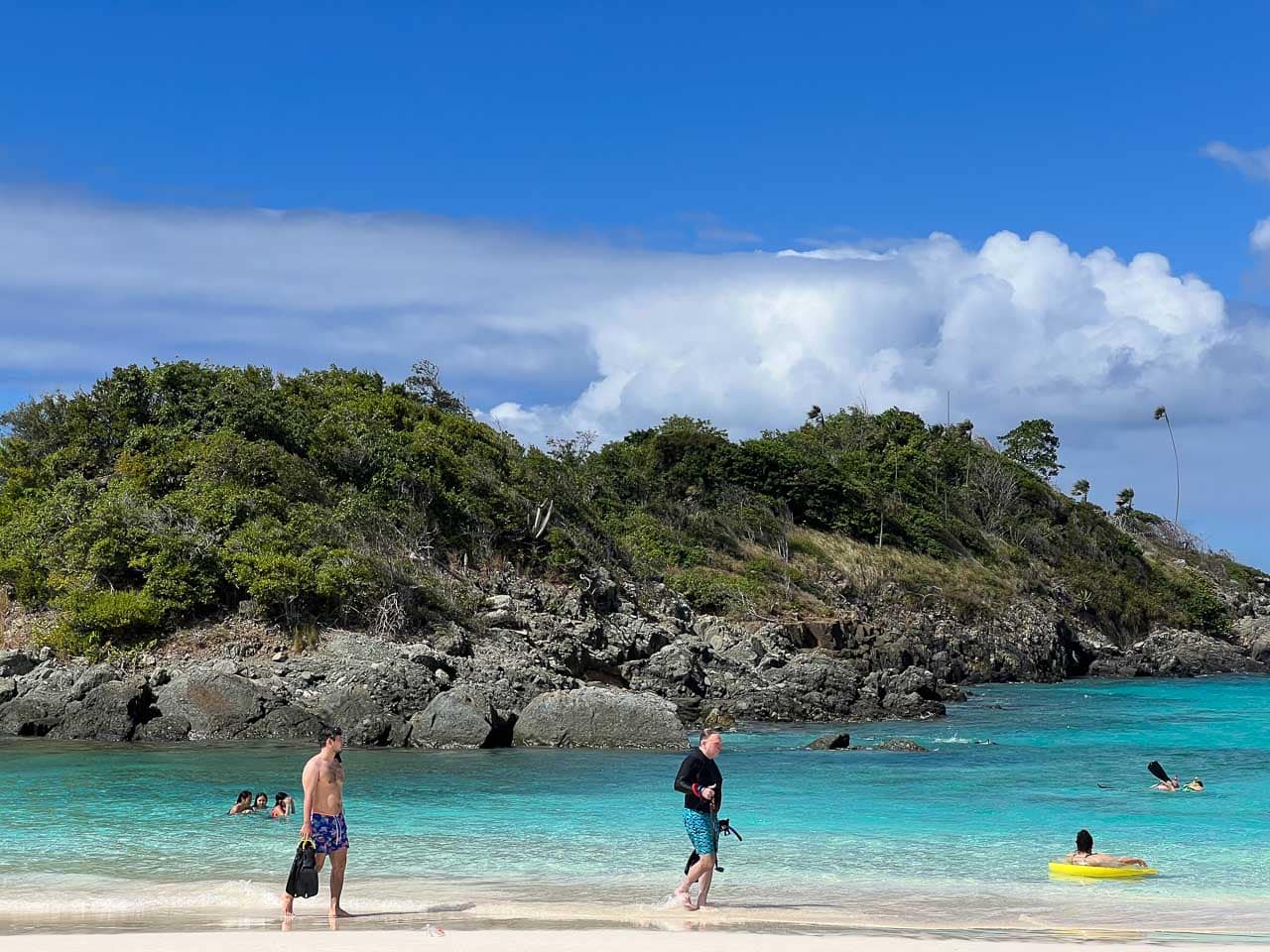
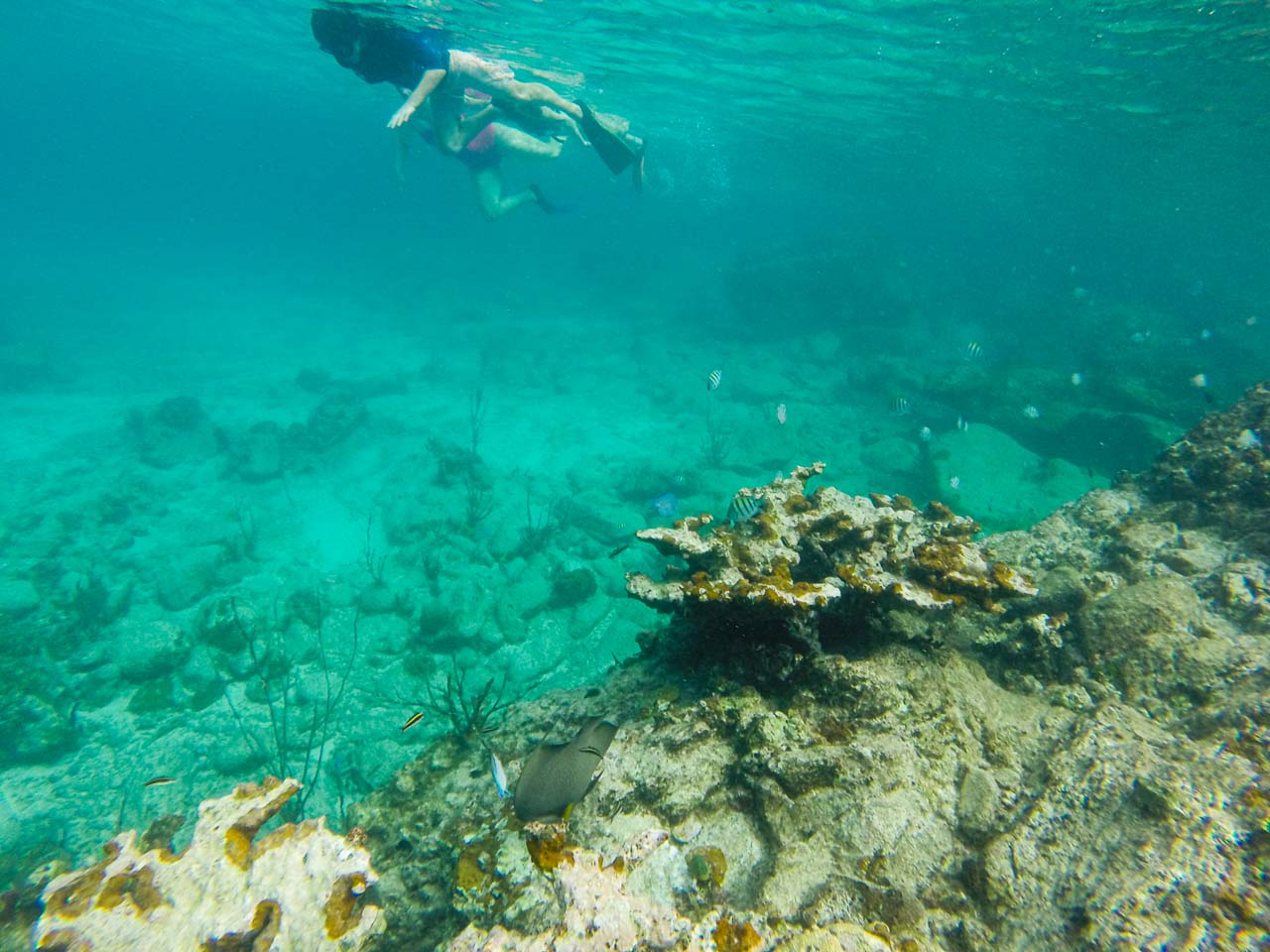
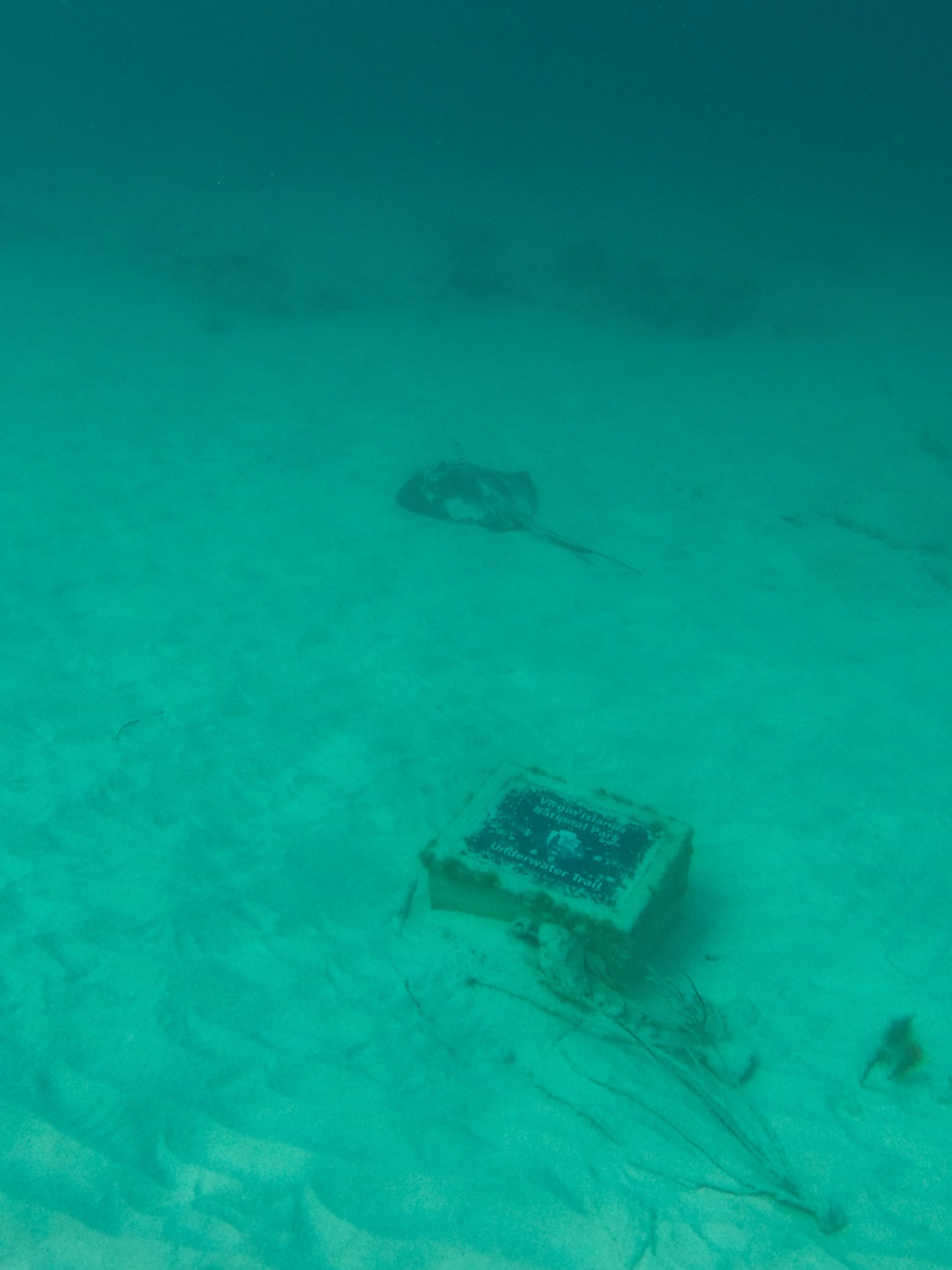
The National Park Service’s statement that “Trunk Bay is considered one of the most beautiful beaches in the world” says it all.
Named after the leatherback turtle, which are known as “trunks” in the Virgin Islands, this beach is the definition of postcard-perfect. When driving from Cruz Bay, make sure to stop at the Trunk Bay Overlook for one of the most iconic views in the entire Caribbean.
At Trunk Bay itself, be prepared to pay the day-use fee of $5 per person. This is the only beach in Virgin Islands National Park that charges a fee. In return, however, you get excellent and clean facilities, access to one of the planet’s greatest beaches, and the extraordinary Underwater Snorkel Trail.
This 225-yard snorkel trail follows the west side of Trunk Bay Cay before looping back toward the beach. Numerous fish can be seen here, including angelfish, parrotfish, sergeant majors, trumpetfish, yellowtail snappers, and the occasional barracuda.
Other marine creatures that call Trunk Cay home are stingrays, sea turtles, and squid.
Other amenities include restrooms, showers, foot rinses, watersports rentals, and food and beverage concessions—featuring the “world’s earliest happy hours” from 9 to 11 am!
Trunk Bay Beach, as famous and popular as it may be, will absolutely live up to your expectations. It’s a glorious beach, with soft white sand, plenty of shade-providing trees, great amenities, and world-class snorkeling.
NOTE: Trunk Bay Beach is extremely popular and its parking lot is relatively small. This means that you should get there by 10 am at the latest if you want to find a spot. Usually all spaces are taken by mid-morning. Many people do tend to leave during the day, though, so you can always try coming back in the afternoon.
3. Maho Bay
Location: Just east of Cinnamon Bay on North Shore Road.
Getting there: Roadside parking lot
Amenities: Restrooms, picnic tables and pavilions, watersports and beach chair rentals, food truck and snack bars, beach bar
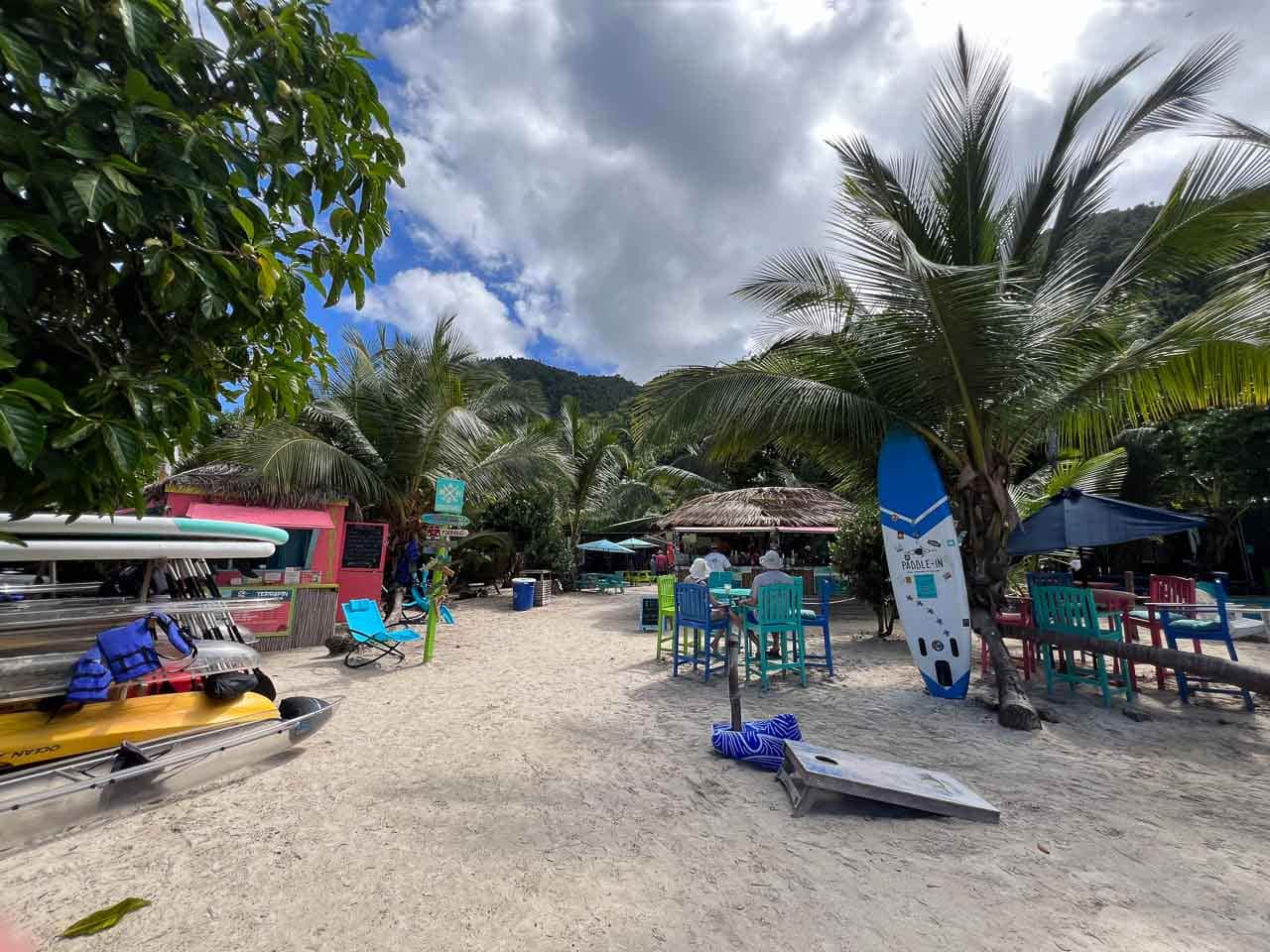
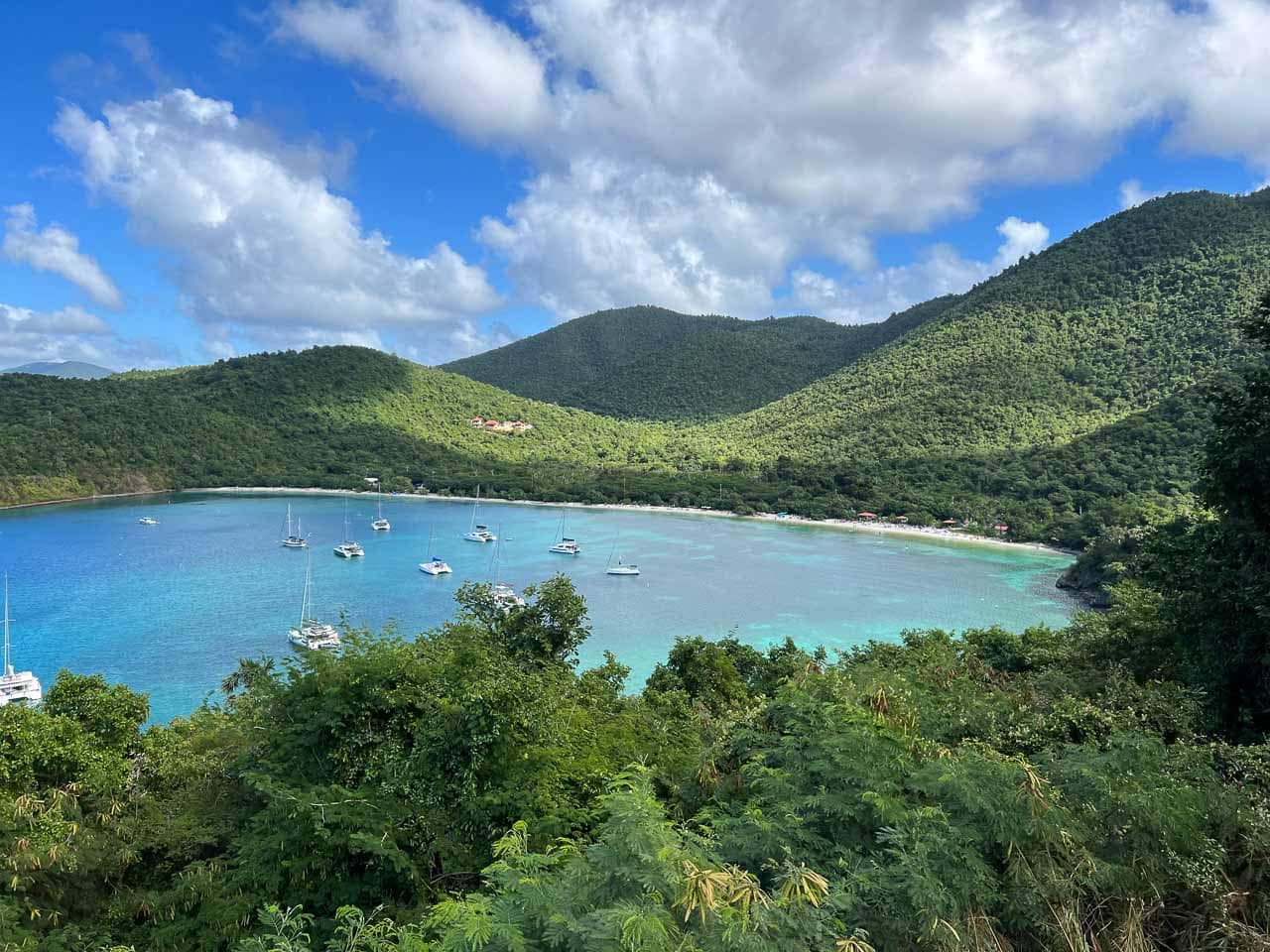
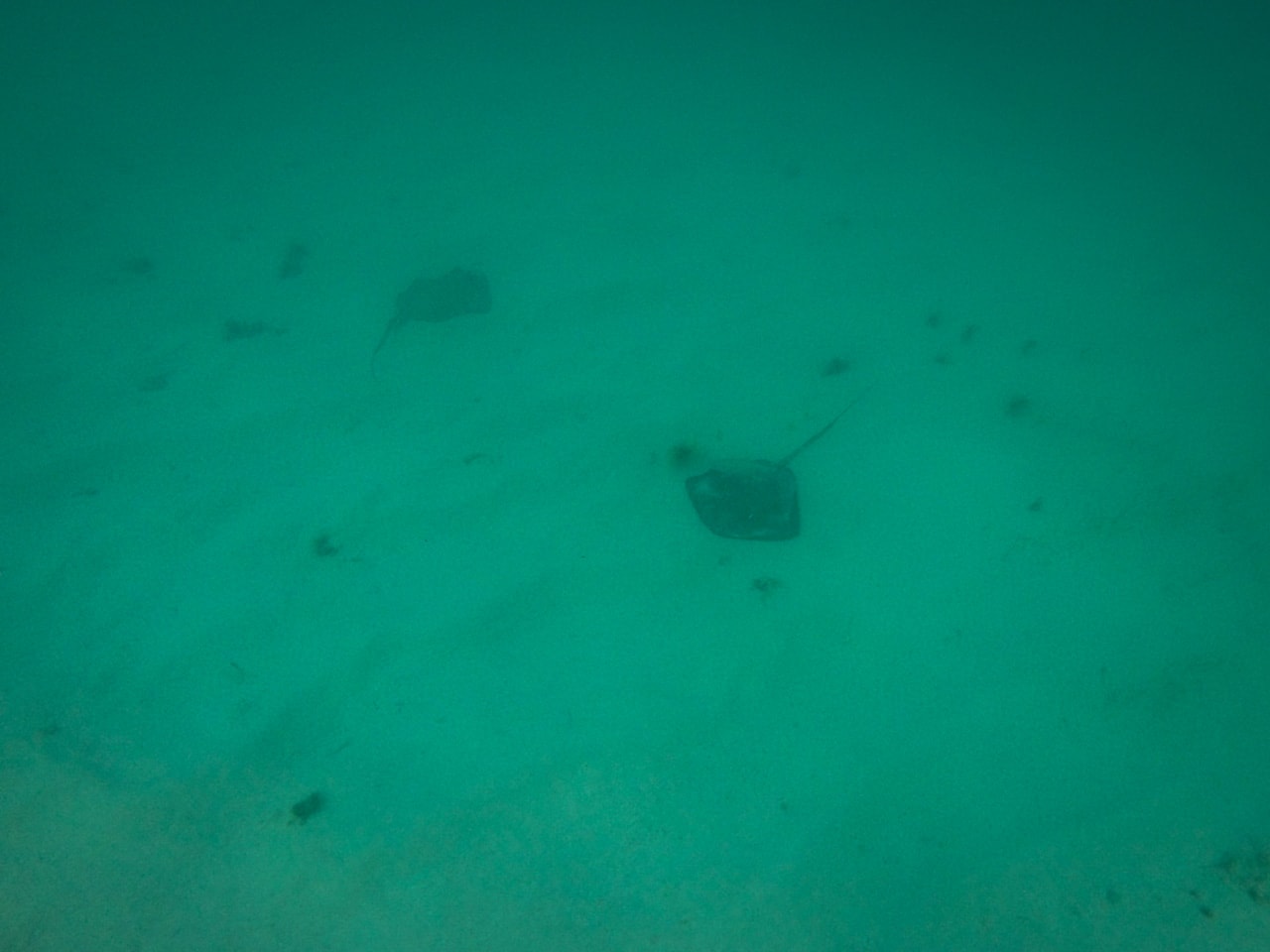
I can’t overstate what a beauty Maho Bay Beach is. It’s easily one of my favorite places to some watersports, including snorkeling, in Virgin Islands National Park and there are a number of reasons for that.
It’s situated right along North Shore Road—there’s a large parking lot at its eastern end, along with some roadside parking, too.
At its western end, which tends to be the busiest area, you’ll find restrooms, as well as a food truck, a popular tiki bar, souvenir shop, and beach chair and watersports equipment rentals.
For a complete experience at Maho Bay Beach, I do recommend renting a stand-up paddleboard. The bay’s calm and shallow water makes it one of the best places on St. John for some stand-up paddleboarding.
Besides paddleboarding, Maho Bay is also arguably the greatest spot to see sea turtles in Virgin Islands National Park. (Salt Pond Bay and Francis Bay are other excellent places to see turtles.) The best times to see sea turtles while snorkeling are early in the morning or late in the afternoon.
Its large seagrass areas provide food to numerous green sea turtles, while stingrays also hang out here. Along the rocky western shore of Maho Bay, you may find octopuses, corals, and fish like angelfish, wrasses, Atlantic blue tangs, damsel fish, eels, and even nurse sharks (which are generally not dangerous to snorkelers).
4. Francis Bay
Location: At the northern end of North Shore Road, just north of and adjacent to Maho Bay.
Getting there: Roadside parking lot
Amenities: Restrooms, picnic tables
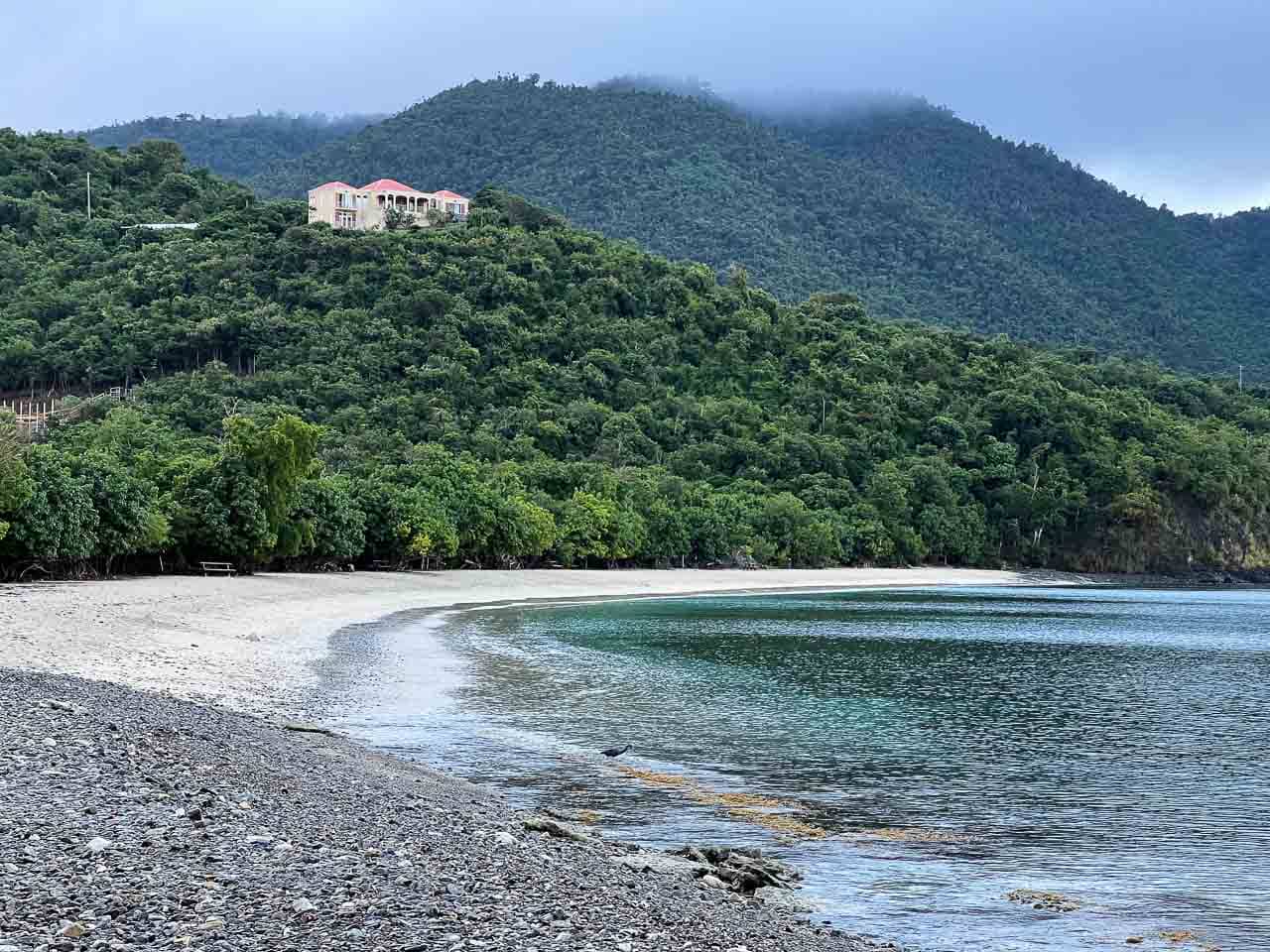
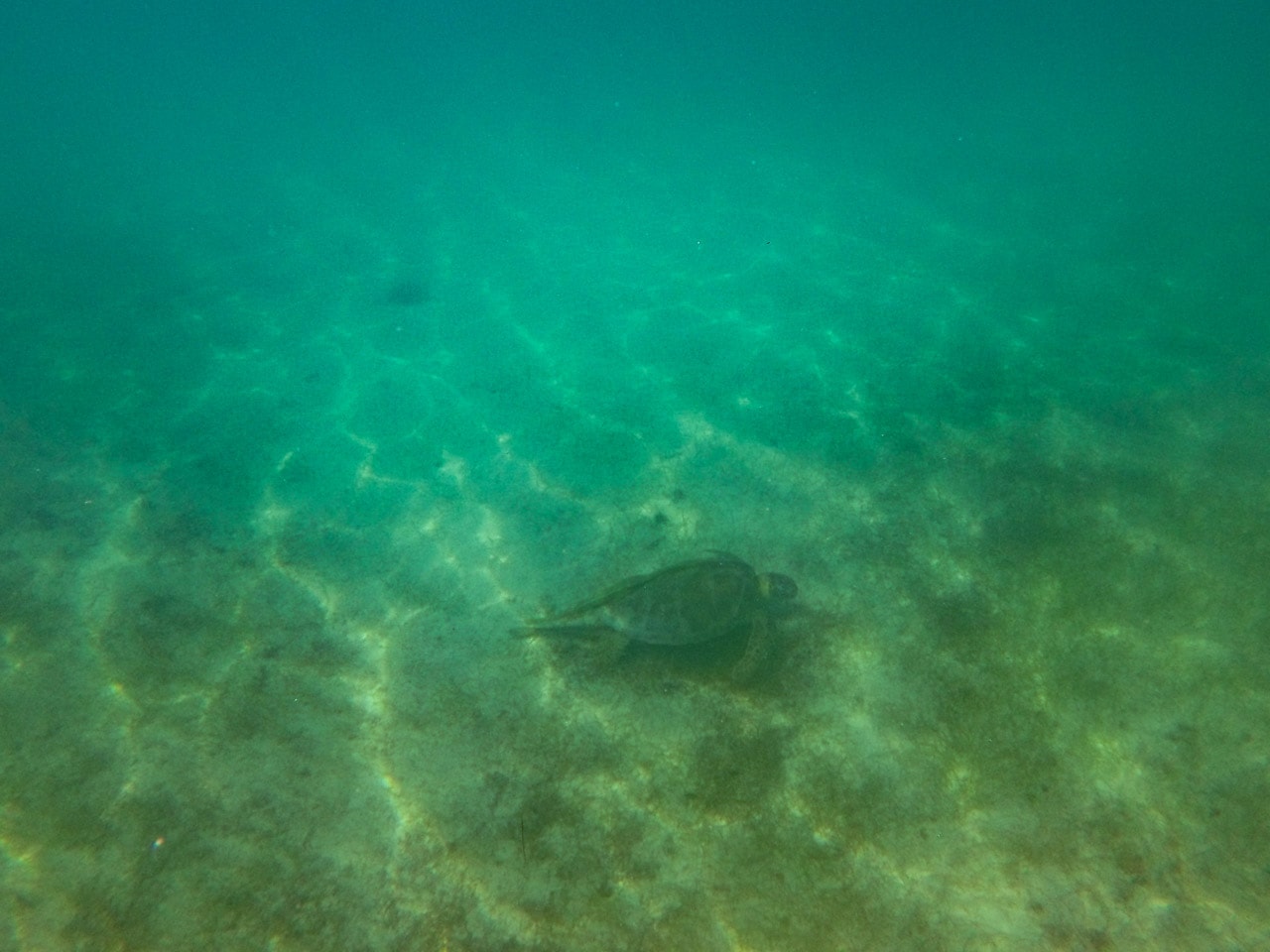
Situated at the northern end of North Shore Road, Francis Bay Beach “is one of the quieter areas of the park and is a great place to view turtles, go for long swims, snorkel along the rock shoreline at the north end of the beach,” according to the National Park Service.
The northern half of the beach is mainly made up of pebbles and small rocks, while its southern portion is beautiful white sand.
Snorkeling opportunities abound here, with a coral reef along the north shore and sprawling seagrass beds along the southern shoreline. These seagrass beds are fantastic places to see sea turtles and stingrays.
Other marine creatures you may see at Francis Bay include large predator fish chasing schools of juvenile fish, gorgonians, colonial anemones, and tube sponges.
Additionally, Francis Bay also has a boardwalk trail, which provides excellent bird watching along the salt pond, and is home to the ruins of the Francis Bay Sugar Factory ruins.
5. Waterlemon Bay & Cay
Location: In the western portion of Leinster Bay, on the north shore of St. John.
Getting there: Easy 1.6-mile roundtrip hike
Amenities: /
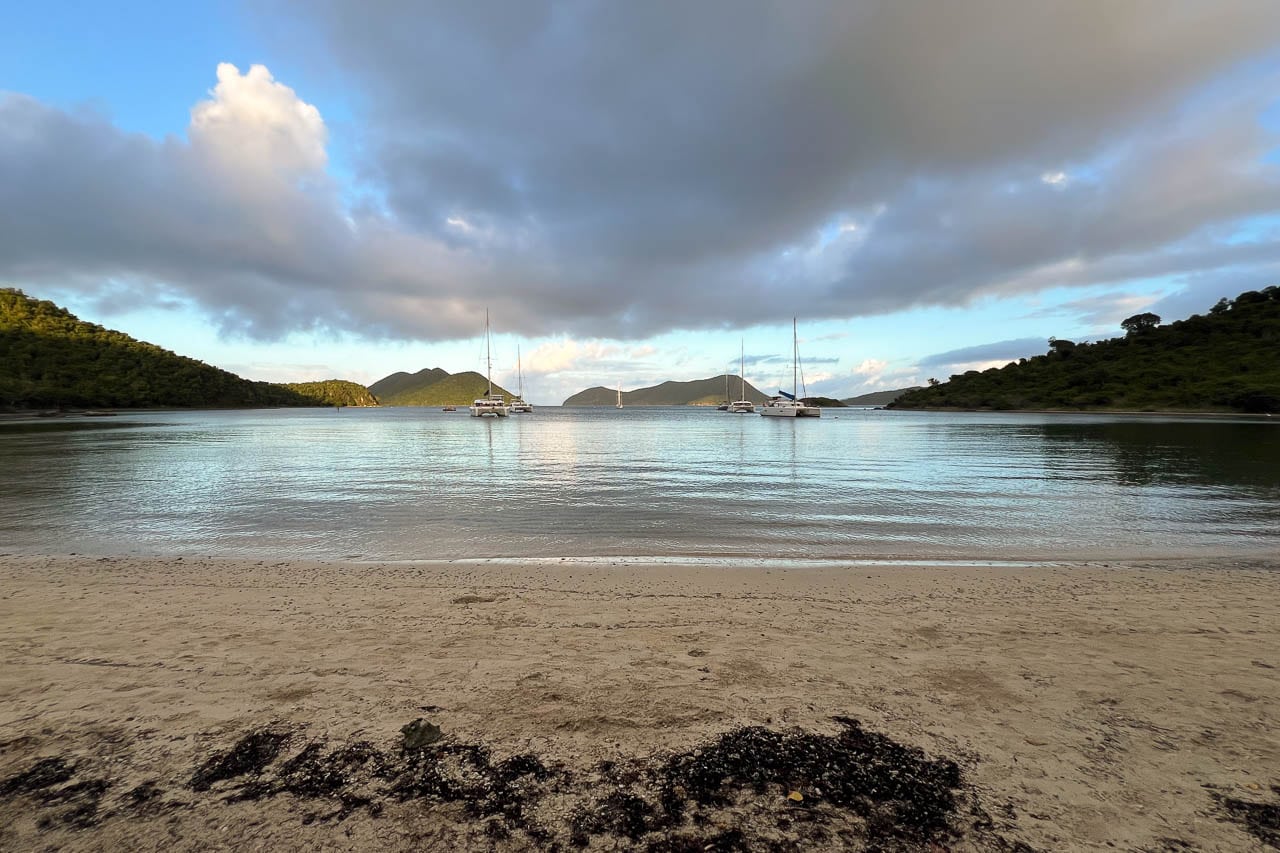
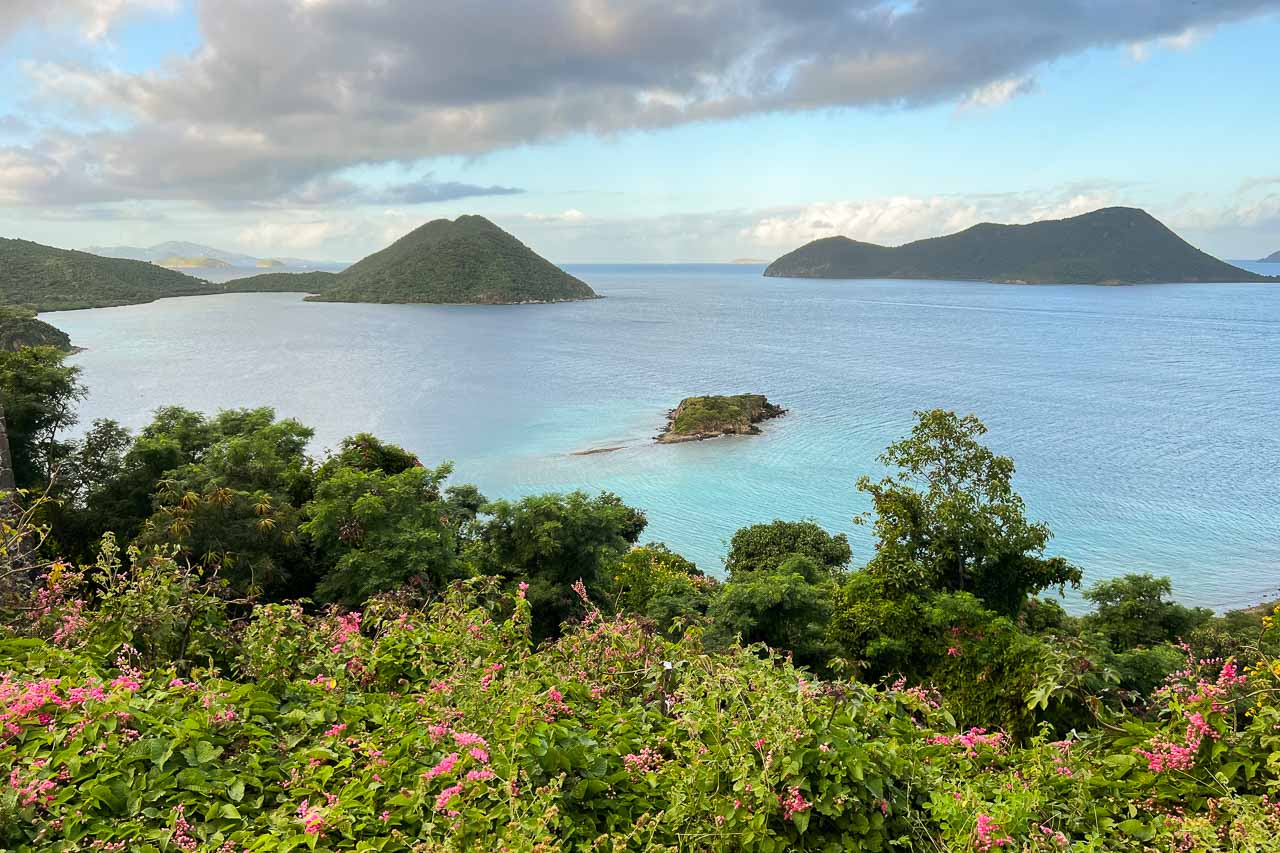
Waterlemon Bay is a smaller bay within the larger Leinster Bay, which is on the north shore of St. John. This scenic bay can be reached only by boat or on foot via the Leinster Bay Trail.
About 0.8 miles one way, the Leinster Bay Trail starts at the Annaberg Sugar Mill ruins (which is a must-visit historical attraction in the national park). It ends at the main beach of Leinster Bay, which is also known as Waterlemon Bay Beach.
This long beach, which partially wraps along the bay, is a combination of gravel and sand and offers access to seagrass beds and rocky shoreline. For snorkelers, the main drawcard of Waterlemon Bay is Waterlemon Cay, often regarded as one of the best snorkeling spots in the U.S. Virgin Islands.
From the narrow stretch of sand at Waterlemon Bay Beach, you can access a shallow reef of coral heads, which is home to all kinds of small fish and other animals. A bit further out, you’ll find a steep drop-off where you might see sea turtles, blue chromis, and gorgonians.
Experienced snorkelers can swim out to Waterlemon Cay, a world-class snorkeling spot that harbor an incredible diversity of marine life. Look for long-spined sea urchins, conches, starfish, parrotfish, Atlantic blue tangs, bluehead wrasses, and a wide variety of corals.
WARNING! A strong current runs along the north side of Waterlemon Cay, so it’s advisable to stay on the islet’s south side.
Besides sunbathing, swimming, and snorkeling, there’s also great hiking in this area. If you take the Leinster Bay Trail to Waterlemon Bay Beach, I highly recommend continuing your hike on the Johnny Horn Trail.
From the start of the Johnny Horn Trail at the far end of the beach, it’s about 0.5 relatively steep miles to the top of Windy Hill. This is where you’ll find the spectacular Murphy Great House ruins.
This is without question one of the greatest views in Virgin Islands National Park, a 360-degree panorama that takes in Leinster Bay, Waterlemon Cay, and Tortola in the British Virgin Islands.
6. Salt Pond Bay
Location: At the far southeastern point of St. John, near the end of Route 107, south of Coral Bay.
Getting there: Moderate 1-mile roundtrip hike
Amenities: Restrooms, picnic benches
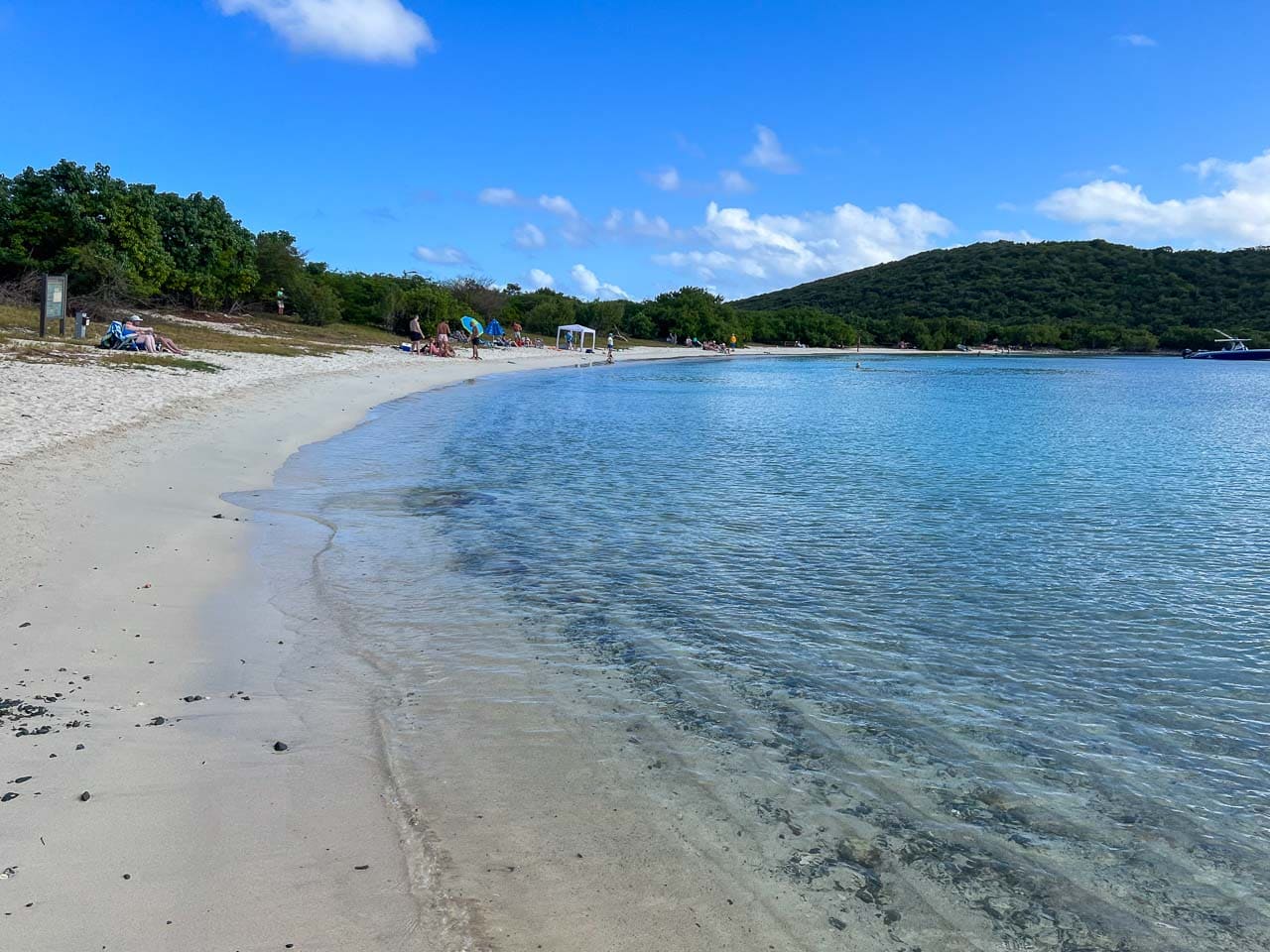
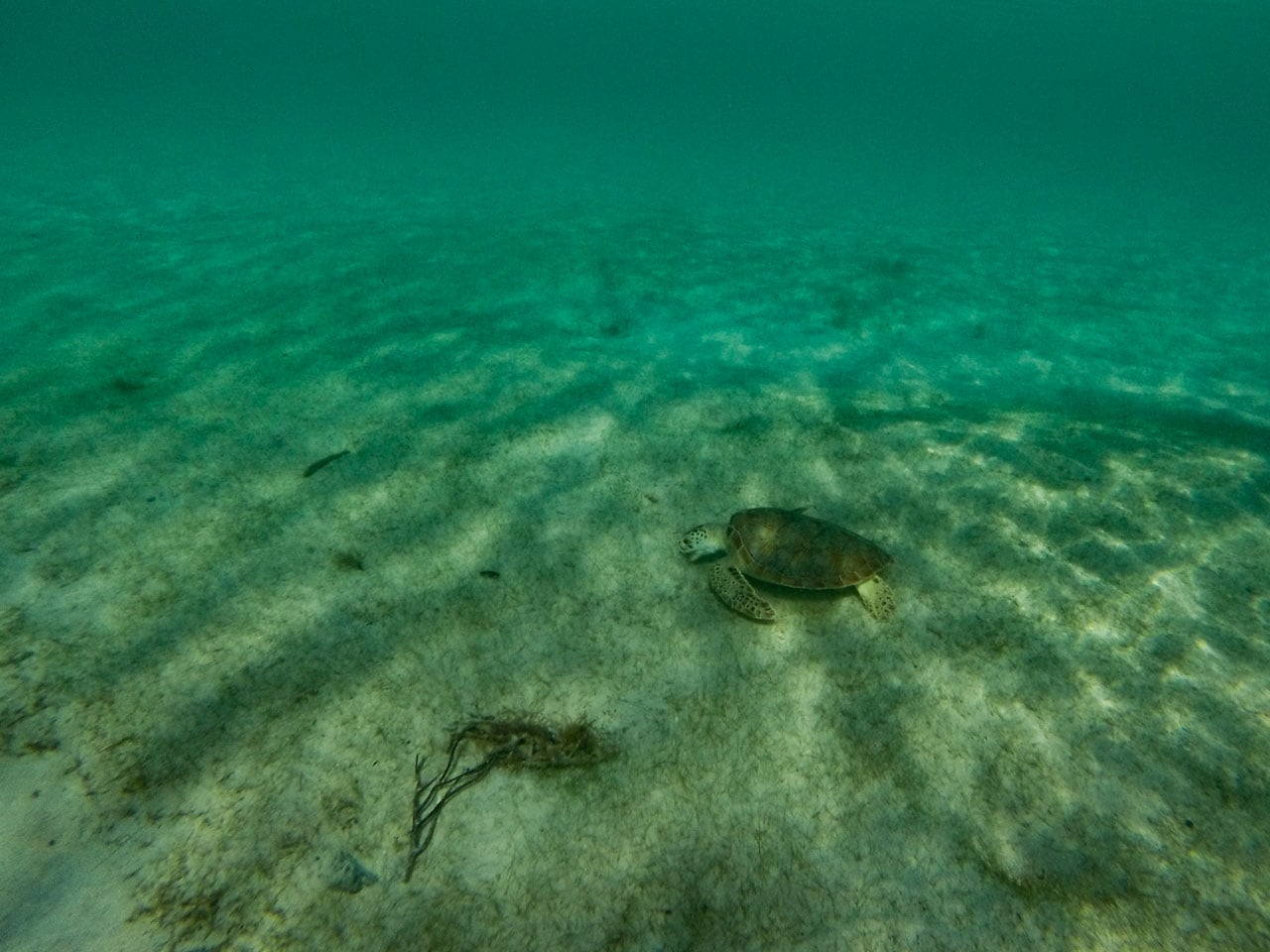
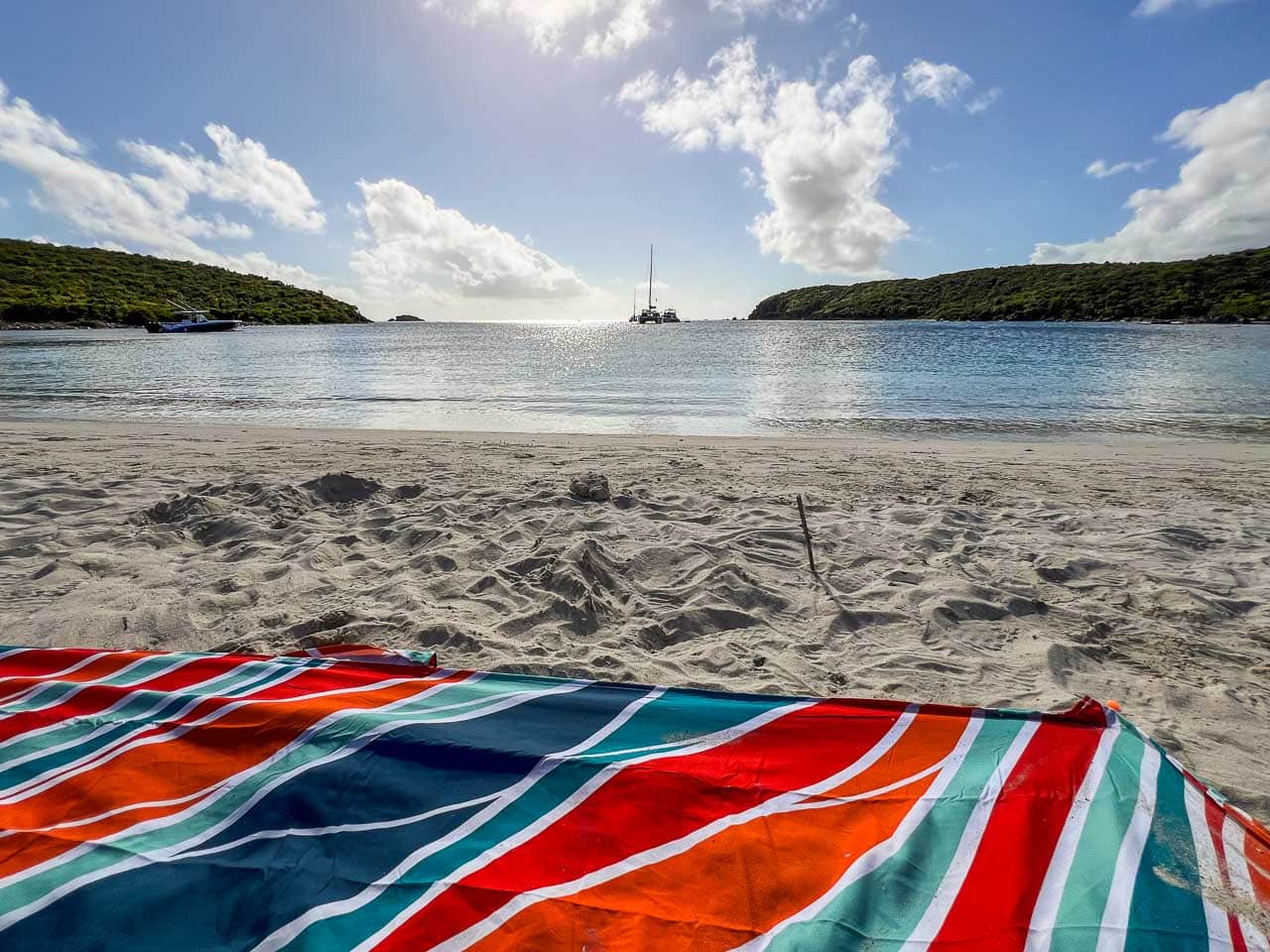
Salt Pond Bay Beach was the beach that positively surprised me the most when visiting Virgin Islands National Park. It’s an objectively beautiful beach, with fantastic snorkeling and one of the best hikes in the park.
You’ll find this gem of a beach down the rather steep 0.5-mile Salt Pond Bay Trail, which starts at a parking lot on the southern section of Route 107.
It’s located on the very opposite side of St. John from other popular Virgin Islands National Park beaches like Trunk, Cinnamon, and Maho—near the island’s southeasternmost point.
The beach itself is crescent-shaped, curving around shallow Salt Pond Bay. This bay is known for its seagrass beds in the middle, while rocky shores and coral reefs are found along its northern and southern portions.
Definitely bring your snorkeling gear to Salt Pond Bay Beach! The large seagrass beds are home to many sea turtles and southern stingrays. I saw a green turtle literally ten seconds after I started snorkeling here.
In addition to its scenic beauty and excellent snorkeling, Salt Pond Bay is also the starting point of the Ram Head Trail.
My favorite hike in Virgin Islands National Park, this 1.8-mile roundtrip hike takes you to the top of cactus-dotted Ram Head, the southern point of St. John, where the views are nothing short of sensational.
If you have enough time, I recommend spending a full afternoon at Salt Pond Bay, dividing your time between sunbathing, snorkeling, and hiking.
Map of the Best Spots for Snorkeling in Virgin Islands National Park
Please refer to the map below for the general location of each of those amazing snorkeling spots in Virgin Islands National Park.
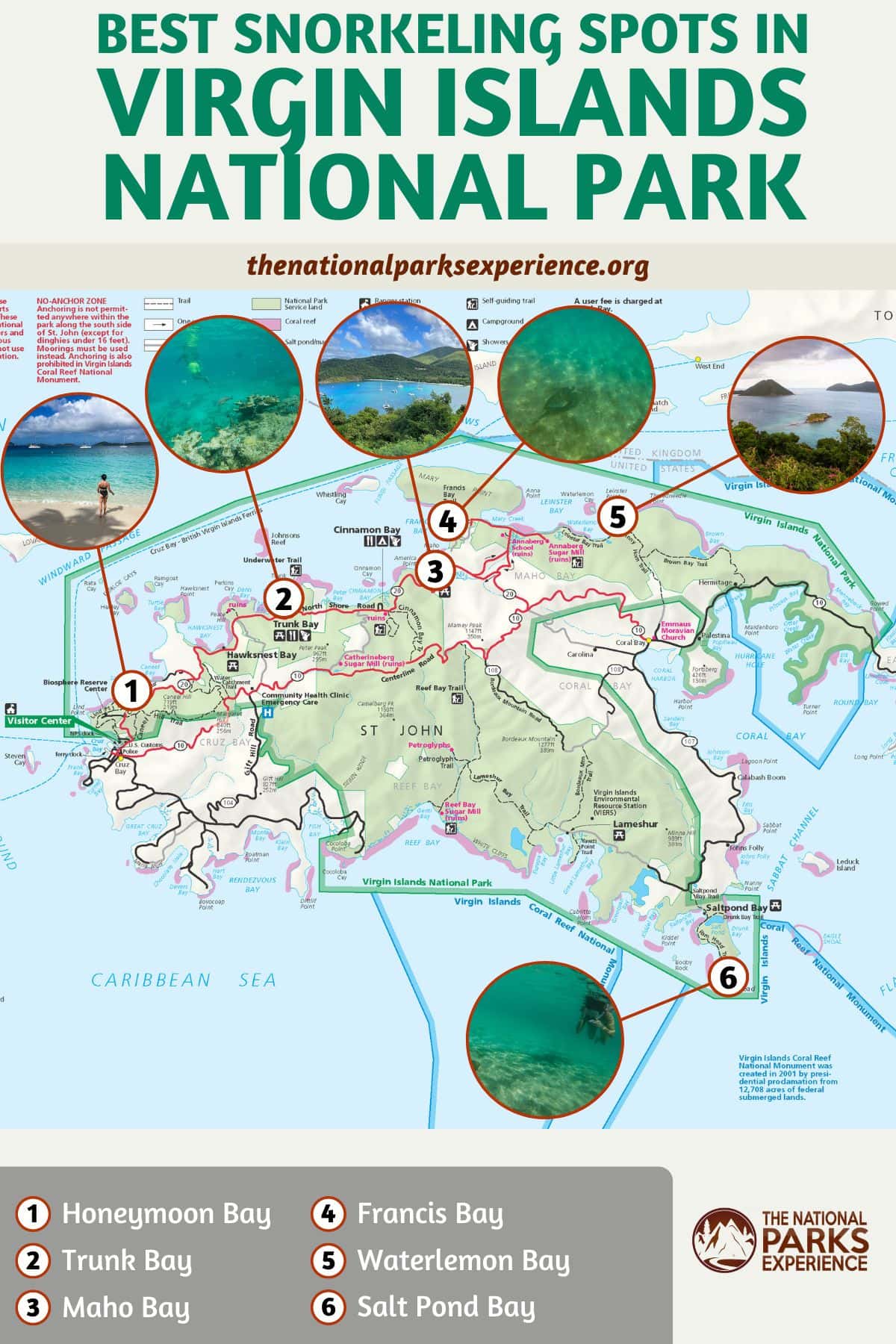
Other Snorkeling Locations in St. John’s Virgin Islands National Park
In addition to the half-dozen Virgin Islands National Park snorkeling spots highlighted above, there are a number of other snorkeling locations. These are, however, somewhat “less” than the others, whether it’s because they’re less accessible, feature fewer marine creatures, and/or don’t have a nice beach.
- Hawksnest Bay
- Brown Bay
- Little and Great Lameshur Bays
- North and South Haulover Bays
More About Virgin Islands National Park
- Park Website
- Travel Guide
- Topographic Map
- Most Beautiful Beaches in Virgin Islands National Park
- Best Views in Virgin Islands National Park
- Best Hikes in Virgin Islands National Park
- Historic Plantation Ruins in Virgin Islands National Park
- Best Time to Visit Virgin Islands National Park
- Accommodation

